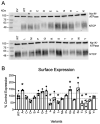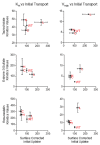Structural Plasticity Is a Feature of Rheostat Positions in the Human Na+/Taurocholate Cotransporting Polypeptide (NTCP)
- PMID: 35328632
- PMCID: PMC8954283
- DOI: 10.3390/ijms23063211
Structural Plasticity Is a Feature of Rheostat Positions in the Human Na+/Taurocholate Cotransporting Polypeptide (NTCP)
Abstract
In the Na+/taurocholate cotransporting polypeptide (NTCP), the clinically relevant S267F polymorphism occurs at a "rheostat position". That is, amino acid substitutions at this position ("S267X") lead to a wide range of functional outcomes. This result was particularly striking because molecular models predicted the S267X side chains are buried, and thus, usually expected to be less tolerant of substitutions. To assess whether structural tolerance to buried substitutions is widespread in NTCP, here we used Rosetta to model all 19 potential substitutions at another 13 buried positions. Again, only subtle changes in the calculated stabilities and structures were predicted. Calculations were experimentally validated for 19 variants at codon 271 ("N271X"). Results showed near wildtype expression and rheostatic modulation of substrate transport, implicating N271 as a rheostat position. Notably, each N271X substitution showed a similar effect on the transport of three different substrates and thus did not alter substrate specificity. This differs from S267X, which altered both transport kinetics and specificity. As both transport and specificity may change during protein evolution, the recognition of such rheostat positions may be important for evolutionary studies. We further propose that the presence of rheostat positions is facilitated by local plasticity within the protein structure. Finally, we note that identifying rheostat positions may advance efforts to predict new biomedically relevant missense variants in NTCP and other membrane transport proteins.
Keywords: protein plasticity; rheostat; transmembrane protein.
Conflict of interest statement
The authors declare no conflict of interest.
Figures






Similar articles
-
Rheostats, toggles, and neutrals, Oh my! A new framework for understanding how amino acid changes modulate protein function.J Biol Chem. 2024 Mar;300(3):105736. doi: 10.1016/j.jbc.2024.105736. Epub 2024 Feb 8. J Biol Chem. 2024. PMID: 38336297 Free PMC article. Review.
-
A clinically relevant polymorphism in the Na+/taurocholate cotransporting polypeptide (NTCP) occurs at a rheostat position.J Biol Chem. 2021 Jan-Jun;296:100047. doi: 10.1074/jbc.RA120.014889. Epub 2020 Dec 2. J Biol Chem. 2021. PMID: 33168628 Free PMC article.
-
Viral entry of hepatitis B and D viruses and bile salts transportation share common molecular determinants on sodium taurocholate cotransporting polypeptide.J Virol. 2014 Mar;88(6):3273-84. doi: 10.1128/JVI.03478-13. Epub 2014 Jan 3. J Virol. 2014. PMID: 24390325 Free PMC article.
-
Interaction of fluvastatin with the liver-specific Na+ -dependent taurocholate cotransporting polypeptide (NTCP).Eur J Pharm Sci. 2011 Nov 20;44(4):487-96. doi: 10.1016/j.ejps.2011.09.009. Epub 2011 Sep 16. Eur J Pharm Sci. 2011. PMID: 21945488
-
Sodium-dependent bile salt transporters of the SLC10A transporter family: more than solute transporters.Pflugers Arch. 2014 Jan;466(1):77-89. doi: 10.1007/s00424-013-1367-0. Epub 2013 Oct 3. Pflugers Arch. 2014. PMID: 24196564 Free PMC article. Review.
Cited by
-
Substitutions at rheostat position 52 of LacI have long-range effects on the LacI conformational landscape.Biophys Chem. 2025 May-Jun;320-321:107414. doi: 10.1016/j.bpc.2025.107414. Epub 2025 Feb 16. Biophys Chem. 2025. PMID: 39987706
-
Rheostatic contributions to protein stability can obscure a position's functional role.Protein Sci. 2024 Jul;33(7):e5075. doi: 10.1002/pro.5075. Protein Sci. 2024. PMID: 38895978 Free PMC article.
-
Rheostats, toggles, and neutrals, Oh my! A new framework for understanding how amino acid changes modulate protein function.J Biol Chem. 2024 Mar;300(3):105736. doi: 10.1016/j.jbc.2024.105736. Epub 2024 Feb 8. J Biol Chem. 2024. PMID: 38336297 Free PMC article. Review.
-
Odd one out? Functional tuning of Zymomonas mobilis pyruvate kinase is narrower than its allosteric, human counterpart.Protein Sci. 2022 Jul;31(7):e4336. doi: 10.1002/pro.4336. Protein Sci. 2022. PMID: 35762709 Free PMC article.
-
Dynamics-based protein network features accurately discriminate neutral and rheostat positions.Biophys J. 2024 Oct 15;123(20):3612-3626. doi: 10.1016/j.bpj.2024.09.013. Epub 2024 Sep 13. Biophys J. 2024. PMID: 39277794
References
-
- Pan W., Song I.S., Shin H.J., Kim M.H., Choi Y.L., Lim S.J., Kim W.Y., Lee S.S., Shin J.G. Genetic polymorphisms in Na+-taurocholate co-transporting polypeptide (NTCP) and ileal apical sodium-dependent bile acid transporter (ASBT) and ethnic comparisons of functional variants of NTCP among Asian populations. Xenobiotica. 2011;41:501–510. doi: 10.3109/00498254.2011.555567. - DOI - PubMed
MeSH terms
Substances
Grants and funding
LinkOut - more resources
Full Text Sources
Research Materials

